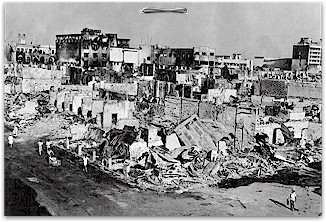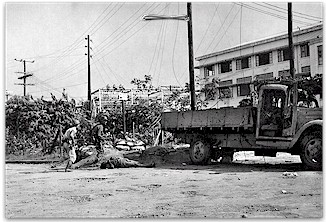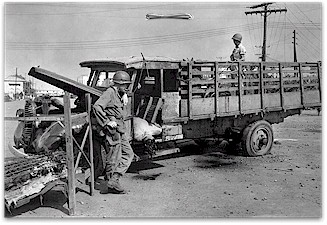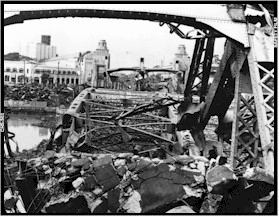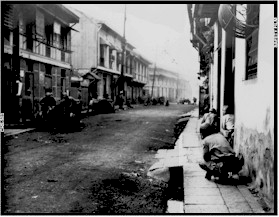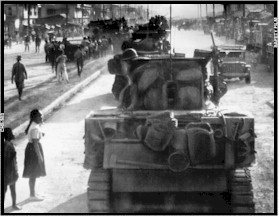|
Tommy gun vs. sniper
6 Feb 45 - Keeping well back in the
shadows and searching with binoculars for "targets of opportunity," Butler
noted a loading dock on a factory only 50 yards to his right front. The
huge loading door was open and there was a timber, about 2"x8" across the
opening at its base. Watching for several minutes, a movement was detected
in the darkened factory, on the floor directly behind the 2x8 at its right
edge (looking out.) Guessing it to be a sniper, who may have detected a
slight movement in the stairwell OP, Butler dropped to one knee with Tommy
gun, took careful aim at the suspect location, and squeezed off about one
half magazine (10 rounds, .45 Cal,) ricocheting off the concrete loading
platform and blowing the 2x8 to toothpicks. Kill not confirmed just hope
it wasn't some curious civilian.
Expecting that return fire would be directed to the
OP, Butler and Phillips departed to the street, across it and behind a
high wooden gate leading to another factory's loading dock. McClelland was
contacted and given our situation. He informed us that 2nd Bn., 148th
Inf., was bedding down for the night in preparation for crossing the river
the next day and we should come on back. Butler replied that it was early
yet and he'd like to go back "across the street" and have another look.
With that OKd, the OP party returned to the stairwell across the street.
No retaliatory fire had been generated by the Tommy gun burst, so a more
careful examination of the surrounding area was undertaken. As the sun was
setting on and slanting from Manila Bay on our right, directly ahead and
about 500 yards away was a loft-type building among lower houses,
something of a mixed zoning mess. The interesting feature of the loft
building was the camouflage paint. It may have helped against aerial
observation, but drew attention from the ground.
Adjusting with two WP rounds at 2200 yards and
quickly switching to "HE, volley 1 round, fire for effect," the four
rounds hit the building, which blew sky high and burned very brightly (a
fireworks factory?). McClelland could see the flames from about a mile
behind the OP and promptly suggested it was time to get some much-needed
rest.
First 4.2-inch shell fired in Manila
6 Feb 45 - Carlisle, in Lines
From Luzon, tells us that Rubin's 1st platoon, Co. D, which was
attached to the 129th Infantry, 37th Division, had the honor of firing the
first 4.2 mortar shells in Manila. The date was 6 February, the
time 1630, the target the beautiful General Post Office."
6 Feb 45 - Discrepancy: The General Post Office
was located along the south shore of the Pasig River, which indicates that
Rubin fired no 4.2-inch mortar shells at targets north of the river in
support of 129th Infantry. Butler's 2nd platoon, Co. C, attacked the
"fireworks factory" north of the Pasig, which was destroyed near dusk on
the 5th, and had fired several missions throughout the day supporting 2nd
Bn., 148th Infantry.
Comment: The sequence of events in crossing
the Pasig River by 37th Division units raises questions about Carlisle's
reported date when Rubin fired on the GPO. The following describes
elements of the attack into the area of Manila south of the Pasig and
shows that the 129th Infantry, in its protracted amphibious assault on
Provisor Island and the Generator plant, may have received Japanese
artillery and/or mortar fire from the GPO 1,300 yards northwest of and
downstream from the island. The GPO, however, was not taken under assault
until 17 February and then by the 145th Infantry, which had relieved the
devastated 129th. Company A, 82nd CMB, was supporting the 145th Infantry.
However, it was normal for a 4.2-inch mortar unit to stay in place when
its supported infantry unit went into reserve.
The 37th Division and the 1st Cavalry Division had
accomplished much during the week ending 10 February. They had cleared all
Manila and its suburbs north of the Pasig, and pushed Colonel Noguchi's
Northern Force either south across the Pasig or east across the Marikina.
Noguchi had executed his assigned demolitions and then withdrawn most of
his troops south across the Pasig, destroying the bridges behind him. (S.
p. 257) Note: At this time, the 82nd Chemical Mortar Battalion was
disposed as follows:
Co. C attached to 148th Infantry
Co. D attached to 129th Infantry
Co. A attached to
145th Infantry
Co. B attached to 40th Division
still back in the Zambales Mountains
The approach to the city was uneventful in comparison
to the resistance encountered once the American forces entered Manila.
Fire missions for the mortars picked up immediately. The weapon screened
regimental crossings of the Pasig River, which bisects the city, and fired
support, incendiary, and neutralization missions, mostly in conjunction
with infantry mortars and artillery. (K&B, p. 506)
6 Feb 45 - General Krueger, Sixth
Army commander, had directed XIV Corps to seize the Provisor Island
generating plant (in the Pasig River) forthwith. (S. 258)
7 Feb 45 - Gen Griswold,
accordingly, ordered the 37th Division across the Pasig and assigned it
most of the city south of the river. The 1st Cavalry Division, when it
finished its job in the northern suburbs, would also cross the river and
then swing westward toward Manila Bay on the 37th Division's left. (Ibid)
General Beightler, the 37th Division commander,
ordered the 148th Infantry to make the assault across the Pasig. The 129th
Infantry would follow the 148th and be followed in turn by the 1st
Battalion, 145th Infantry, division reserve. The remainder of the 145th
was to protect the division's line of communications north of Manila.
Beightler directed the 148th Infantry to cross just east of Malacanyan
Palace and land on the south side at Malacanyan Garden. The 148th would
first clear the Paco and Pandacan (industrial) Districts and then wheel
southwest and west toward Intramuros (Walled City) and Manila Bay. The
129th Infantry, once on the south bank, would immediately swing west along
the river to secure Provisor Island and the steam power plant. (S. pp.
258-60)
1515 Hours 7 Feb 45 Behind a 105-mm.
artillery barrage, 3d Battalion, 148th Infantry, began crossing in assault
boats. The first wave encountered no opposition but, as the second
crossed, intense machine gun, mortar and artillery fire began to hit the
river, the landing site, and the Malacanyan Palace area. However, the
148th found only a few Japs at the Malacanyan Gardens and established its
bridgehead with little difficulty. By 2000, two battalions were across the
Pasig, holding an area about 300 yards deep and 1,000 yards along the
river. The crossing had cost the regiment about 15 men killed and 100
wounded, almost all as the result of machine gun and mortar fire. Many of
the casualties had actually occurred on the palace grounds where the 148th
Infantry had its command post and where General Beightler had set up an
advanced headquarters. (Ibid) Also, see Frankel's report regarding
the 148th CP at the Palace, in Chapter 14 of his website Frankel-y
Speaking.
Discrepancy: In describing events at
Malacanyan Palace, Frankel states: It was to be our final drive against
the 25,000 Japanese crammed in the lower half of Manila backed up against
the Pacific Ocean. The Pasig River flows west into Manila Bay, which is a
bay on the South China Sea southwest of Manila. The Pacific Ocean is far
to the east of Luzon beyond the Philippine Sea and the Northern Mariana
Islands.
During our stay north of the Pasig, the 2nd platoon,
Co. C, 82nd CMB, had its vehicles: one Ό-ton truck (jeep) with trailer and
four 2½-ton trucks with trailers for the four gun crews. When the 2nd
Battalion, 148th Infantry, was preparing to cross to the south of the
Pasig, the 2nd platoon mortarmen displaced to a new firing position on the
Malacanyan Palace grounds. From that location on the north bank of the
Pasig it was possible to reach directly west along the river to Manila Bay
and southwest to the Bay well within the 148th Infantry's zone of advance.
The Japs had cut all bridges and it was not feasible
to get wire across the river. Reliance would have to be on the SCR-300 for
communication and Phillips would backpack it through the streets of South
Manila. A beefed-up OP party crossed with the 2nd Bn., 148th Infantry,
about 2000 hours on the 7th and had no fire mission until early on the 8th
when the clearing of the Paco and Pandacan Districts started.
The OP party consisted of Butler, with his Tommy gun
in hand, .45 Cal. pistol in shoulder holster, a 7-round magazine in the
pistol, two 7-round magazines in the belt pouch, a map case, binoculars,
and bag of four 20-round magazines for the Tommy gun, in addition to the
one in the gun, giving a total of 121 rounds of heavy Cal. .45 ammunition;
Phillips backpacking the SCR-300 radio and his carbine; a bazooka team
made up of Ward carrying the bazooka with one round loaded and his own
carbine, and Shaeffer backpacking two 3.5 rockets for the bazooka, plus a
carbine.
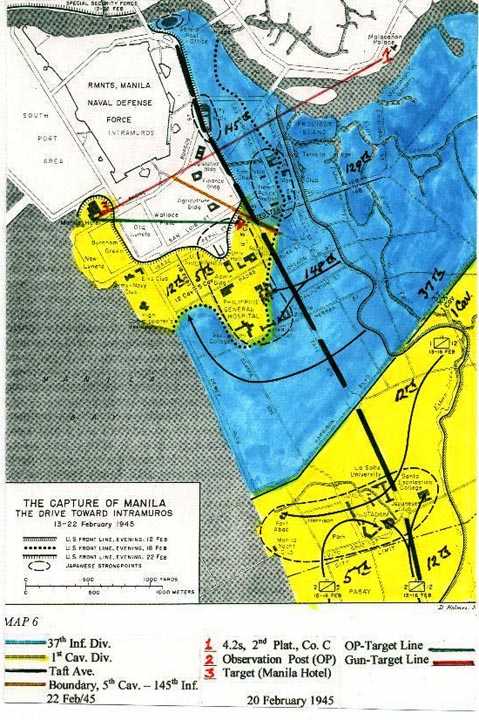
Map
6 (above), from Smith's Triumph in the Philippines (S.
p. 276), has been color-coded to more graphically display the progress of
the battle and the disposition of friendly forces. Blue, the infantry
color, and yellow for cavalry, show how the 148th Infantry of the 37th
Division assaulted south across the Pasig to clear the industrial
districts, then wheeled west toward Intramuros and southwest toward Manila
Bay. Also displayed is the advance of the 1st Cavalry Division which, as
directed, had crossed the river and swung westward toward Manila Bay on
the 37th Division's left.
9 Feb 45 - In the evening, one troop
of the 8th Cavalry Regiment, 1st Cavalry Division, crossed the Pasig about
two miles upstream (east) of the 148th Infantry's crossing at Malacanyan
Palace. The crossing was at the Philippine Racing Club just east of the
city limits (not shown on Map 6). The rest of the regiment was across at
the same point by 0950 on the 10th. The cavalry encountered practically no
opposition in the crossing area, but progressed slowly because the
Japanese had thoroughly mined many of the streets south and west of the
club. By dusk on the 10th the 8th Cavalry had secured a beachhead about
1000 yards deep. Its right flank crossed the city limit and extended into
the Santa Ana District where patrols established contact with the 37th
Division (148th Infantry) troops along the division boundary near (east
of) Paco Station; on its left (east), other patrols met men of the 5th
Cavalry. (S. pp.264-65)
10 Feb 45 - By 1500, the 5th Cavalry
Regiment had gotten one squadron across at Makati, a mile east of the
Philippine Racing Club, and had secured the Makati electrical power
station. Considerable machine gun and mortar fire from the Fort McKinley
area, about 2500 yards southeast of Makati, harassed the cavalrymen
throughout the day. (Ibid)
As stated earlier, the observation post (OP) party of
the 2nd platoon, Co. C, 82nd CMB, crossed with the 2nd Battalion, 148th
Infantry, about four to five hours after the initial assault by 3rd
Bn./148th Infantry. Both battalions had crossed by 2000.
Note: Neither Carlisle, Frankel or Smith,
in the works heretofore cited, gives details of the specific battalions of
the 148th Infantry engaged south of the Pasig River, other than Smith's
statements: ...3rd Battalion, 148th Infantry began crossing in assault
boats at 1515 on 7 February... and By 2000 two battalions were across
the Pasig, ... (S. p. 260) The 3rd, 2nd and 1st platoons of Co. C, 82nd
CMB, initially in that order, took part in the battles south of the Pasig
River, each attached to the three respectively numbered infantry
battalions. However, the disposition of the 148th Infantry's elements
south of the Pasig is established in another work by Frankel: Stanley A.
Frankel 37th Infantry Division in World War II, Infantry Journal
Press, Washington, D.C., 1948. This is the official history of the
division compiled by Frankel under the direction of General Beightler and
his staff, who were required by the general to remain in Manila for three
months after the end of the war for that purpose, as related by Frankel in
his previously cited Frankel-y Speaking. This official history of
the 37th Division does contain references to the 82nd Chemical Mortar
Battalion and to 4.2-inch mortars. Future citations from that source will
be designated (F37th and page number(s)).
8-10 Feb 45 - Heavy damage was done
to Paco Station, Paco School, and Concordia College as the 148th Infantry
went about its assigned task of clearing the Pandacan and Paco industrial
districts between 8 and 10 February. The regiment cleared Pandacan
District with little trouble, but in the eastern section of Paco District
had very great trouble reducing the Japanese strongpoint at Paco Railroad
Station and the nearby buildings of Concordia College and Paco School.
Supporting artillery and mortar fires nearly demolished the station and
the school but, as of evening on 9 February, the Japanese, originally over
250 strong, were still holding out and the 148th made plans for a final
assault on the 10th. Happily, most of the surviving Japanese withdrew from
the three buildings during the night. (Ibid)
Moving through city streets had some similarities to
moving through jungle, but very significant differences were to be
demonstrated. A similarity was, in clearing the area as they advanced,
infantrymen always sought to gain the "high ground." In the jungle, that
didn't mean climbing the trees, but in the city it translated to reaching
roofs of buildings, factories, houses, whatever in attempting to clear
from the top down. Once one rooftop was gained, getting access to a top
floor was a simple matter of chopping or blasting holes, throwing down
grenades and repeating the process through walls and floors for clearing
lower floors and accessing adjacent buildings.
10-12
Feb 45 - Map 6, at right (click to enlarge), shows the U.S. front
line as of evening 12 February, at which time the 129th Infantry had
crossed behind the 148th and attacked west along the south bank to become
heavily involved in a costly operation to secure Provisor Island and its
generating plant. After the 129th-148th boundary was set, the 145th
Infantry passed through 129th to take positions alongside 148th facing
west to the heavily fortified complex of government, university, hospital,
hotel, club and other buildings, all sturdily built to withstand
earthquakes and now serving as perimeter defenses for the ultimate
strongpoint: Intramuros, the Walled City.
|



